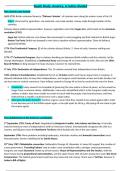Lecture notes
A* condensed detailed notes: AQA A Level History: America: Depth Study
- Module
- American History
- Institution
- AQA
A* condensed notes for AQA A Level History students studying America (the American Civil War.) Written by a student now studying at Oxford University. Following these notes will guarantee you the top marks.
[Show more]





